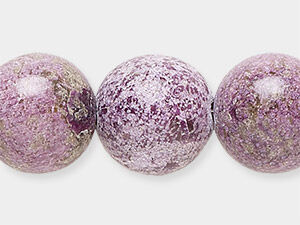Stichtite Meaning and Properties
Stichtite History
Stichtite was discovered in 1910 in Dundas, on the west coast of Tasmania, Australia. It was named after Robert Carl Sticht, the manager of the nearby Mt Lyell copper mine. stichtite is purplish pink to purple rose-red in color. Dark purple stichtite inclusions can also be found in some green serpentine, which is called Atlantisite or Tasmanite. This combination makes interesting specimens and attractive ornamental stones for carvings.
Stichtite Metaphysical Properties
Stichtite is believed to be a stone of rescue, recovery and forgiveness. The gemstone is thought to help heal unresolved issues and emotional issues by promoting feelings of love and compassion. Metaphysical healers use stichtite to assist in restoring emotional and physical health after illness, depression or emotional trauma. Stichtite has a strong effect on the heart, third eye and crown chakras.
Stichtite Geological Properties
Stichtite is a mineral, a hydrated magnesium chromium carbonate, which can be usually found in igneous and metamorphic rock. Stichtite is formed as an alteration product of chromite containing serpentine. Australia is a major source for stichtite, but it has also been found in Brazil, Canada, India, Morocco, Russia, Scotland and Sweden.
|
|
|
|
|
|
|
|
|
|
|
|
|
|
|
|
|
|
Proper Care of Stichtite
Stichtite is very soft with a Mohs hardness of 1-1/2 to 2, and should be treated with care. Clean stichtite with a soft dry cloth. Wash with warm, soapy water and a soft cloth or soft brush. Dry thoroughly. Do not apply harsh cleaning products that can include bleach and acid. Do not use ultrasonic cleaners or steamers.
Designing with Stichtite
Because stichtite has a low hardness, it is best to use this gemstone in jewelry designs that will not receive accidental blows or impact. Necklaces and earrings will provide less stress to stichtite gemstones than rings and bracelets. The pinkish hues of stichtite can be set in contrast with darker materials such as black onyx or Hemalyke™. Conversely, the pink can be augmented with analogous colors such as violet and lilac as well as light-colored gemstones such as morganite, rose quartz and rhodonite.
Shop for Stichtite
**Please note that all metaphysical or healing properties listed are collected from various sources. This information is offered as a service and not meant to treat medical conditions. Fire Mountain Gems and Beads® does not guarantee the validity of any of these statements.
How did you like this resource? Your feedback helps us provide resources that matter to you most.
Copyright Permissions
All works of authorship (articles, videos, tutorials and other creative works) are from the Fire Mountain Gems and Beads® Collection, and permission to copy is granted for non-commercial educational purposes only. All other reproduction requires written permission. For more information, please email copyrightpermission@firemtn.com.

